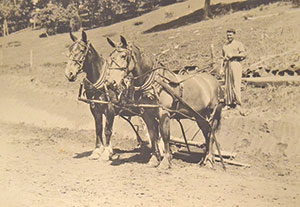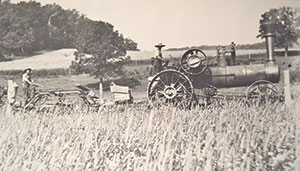By Lee Epps
They came on foot, walking beside a yoke of oxen, which pulled a cart laden with their belongings. Sometimes the women and children rode atop the load in the cart. These were settlers of the early 1850s, making their way into what would become Houston County, Minn.
Some of these migrants had accompanied oxen from as far away as southern Illinois. Others arrived on Mississippi River steamboats before purchasing or hiring oxen for the ensuing overland trek west. There were some who had arranged for previous settlers, friends or family, to meet them at the boat landing with oxen and an empty cart.
A few had horses for the trip or farm work, but that was an exception until the population had increased considerably. The oxen were better suited for the working and traveling conditions of the time. They better tolerated the climate and the weather, especially without much, if any, shelter. They were not picky eaters, able to exist on a wider and unpredictable selection of forage.
Many pioneers followed Indian trails or traversed as best they could through river valleys, over ridges and maybe onward to prairies.

Photo courtesy of the Houston County Historical Society
Better roadways became more necessary as settlers arrived in greater numbers. It was a predominant concern of early governance, The territorial and later state legislators recognized that southeastern Minnesota was an inevitable gateway to settlement in pursuit of agricultural prosperity.
The legislature was unsuccessful with petitions to Congress for funding, so it was left to the people of each county to finance the first roadwork. The legislature did establish several road routes that crossed Houston County. And roadways were a major concern at the first meeting of the Houston County board on May 26, 1854. By July, they had established eight road districts.
Although road travel remained a primary concern of local government, it was a challenging undertaking. Springtime rains made many roads almost impassable. As primitive as were the first roads, they were expensive. The county board also provided for cartways, unimproved trails from the main roads to farm homes.
Many of the first survey markers did not hold up well, and some landowners had begun to fence across roads that crossed their property. In 1858, the county board ordered the removal of all obstructions and provided for new surveys.
A county history in 1919 identified three main routes. Road No. 1 went from the Fillmore County line through Spring Grove, then Wilmington Township, Hokah Township and La Crescent Township before crossing into Winona County.
Road No. 2 entered from Winona County through Money Creek Township, the village of Houston, Sheldon Township, Caledonia, Wilmington, Eitzen and on to New Albin, Iowa.

Photo courtesy of the Houston County Historical Society
Road No. 3 went from Brownsville through Caledonia on the way to New Albin. There was also Road No. 4, which branched off Road No. 2 at the South Fork bridge in Sheldon Township and headed toward Yucatan.
Before bridges were built, ferries were critical links to travel, especially across the Mississippi River. There was also a ferry on the Root River at Houston, beginning in 1858. There was a ship-building yard in Houston, and boats loaded with goods went as far as Rushford.
The county history of 1919 notes a project at that time to improve the Root River that would “make it available for launches, rowboats and canoes, though the current will be so swift that the use of the deepened river for either pleasure or transportation will be almost negligible.”
Ferry licenses were issued by the legislature or county board. The territorial legislature awarded the first license in what became Houston County to Charles Jensen to operate on the Mississippi River with exclusivity for six years with no other ferry within six miles. He was to operate the ferry at all hours but could charge double after 9 p.m.
The regular rate for a passenger on foot was 15 cents. It would cost 50 cents for a horse, mule, cow or ox without a rider. A two-horse, mule or ox team, loaded or unloaded, with a driver could cross for a dollar. The fare for a single horse carriage would cost 75 cents. One could send a swine or sheep across for 4 cents.


Leave a Reply